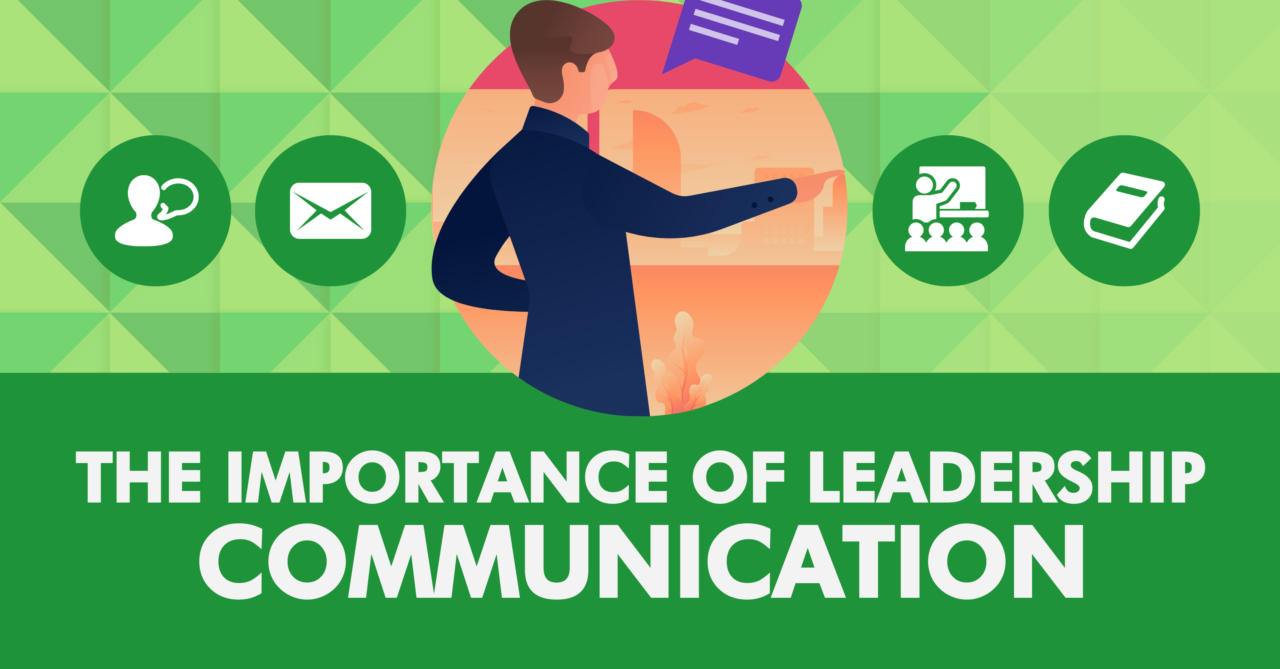
The Importance of Leadership Communication
The key to becoming a great leader has always been being skilled in communication. Especially today, when communication channels are rapidly increasing and the need for connectivity between a leader and their employees is in high demand, effective leadership communication is a definitive cornerstone to business success. If you want to be able to implement changes and produce real business results for your company, you first need to learn the skills necessary to have effective workplace conversations.
Leadership Communication Defined
Looking at effective workplace communication as a 2-way street is important, but it also glazes over some of the complexities involved in communication itself, particularly from a leadership perspective. Effective leadership communication is far from a new business buzz phrase. Rather, it describes a particular approach to workplace communication that has a clear and critical impact on an organization’s bottom line.
Leadership communication consists largely of messages related to a company’s culture and core values. These messages are significant to the key stakeholders of the company, including the employees, customers, strategic partners, shareholders, and media. When it comes to communications from leaders, they are critical because of their direct impact on this relayed message regarding the organization’s vision, mission, and transformations. The most important goal of leadership communication is to cultivate a sense of trust in the workplace through the messaging coming from leaders, keeping employees engaged and focused in the right direction.
The Importance of Leadership Communication
Communication is a core leadership function, meaning effective workplace communication and effective leadership are closely intertwined. An effective leader needs to be a skilled communicator, applying that skill in relationships at the organizational level, in larger communities and groups, and sometimes even on a global scale. However, according to the statistics, 57% of employees report not being given clear directions, and as much as 69% of managers are not comfortable communicating with their employees in general.
The problem here goes beyond managers lacking confidence or the skill levels necessary to be successful business leaders. Rather, leaders who are falling short in the communications department will have a direct negative impact on employee satisfaction, motivation, and productivity levels. Without effective leadership communication in place, a leader cannot and should not expect their employees to be engaged and connected in the workplace, introducing a host of other detrimental impacts on the success of the business.
Keeping employees motivated and driven towards success should remain a top priority for any leader. But, in order to inspire and motivate in the first place, business leaders need to establish and foster a strong line of communication. As a leader, you need to think with clarity, express ideas, and disseminate information to a multitude of audiences. A good leader can handle the rapid flows of information that circulate within the organization, and between customers, partners, and any other stakeholders. Essentially, maintaining strong leadership communication within the workplace is the key to keeping your business not just afloat, but thriving in the industry as a whole.
Tips to Optimize Your Leadership Communication
Fostering strong lines of communication as a leader introduces a particular set of goals that differ largely from the business skill of general communication. As a leader, it is your responsibility not only to have good basic communication skills, but also to ensure that the lines of communication you open within your business cover the following leadership goals:
- Align employees with the company culture.
- Align employees with the company’s strategic goals.
- Build trust within the workplace.
- Maintain employee engagement.
- Encourage two-way conversations and open dialogue.
- Promote employee collaboration and teamwork.
- Keep employees informed.
- Communicate any upcoming changes effectively and in a timely manner.
- Prevent internal miscommunications.
- Disseminate important information and make it available to employees.
Best Practices for Effective Leadership Communication.
Aligning your communications strategy with the above leadership objectives is critical, but how do you know your skills have matured enough to ensure your leadership communication is as effective as it can be? The number one thing great leadership communicators have in common is they have an accurate sense of situational and contextual awareness. That is to say, they are great listeners and astute in their observations, drawing on contextual clues naturally to heighten their communication skillset.
A great leadership communicator can read the individuals or groups they are conversing with, sensing the mood, dynamics, attitudes, values, and concerns associated with the other and can easily adapt their messaging to said environment without missing a beat. To know you have reached the point where your interactions as a leader translate to your presence as an excellent communicator, aim to employ the following best practices into your method of leadership communication:
1. Be honest.
People won’t be open to those they don’t trust, and this is especially true when it comes to leadership. When employees, shareholders, partners, or any other key stakeholders have a sense that a leader is worthy of their trust, they will invest time and take risks for the business in a way that they never would if the leader had a reputation built upon a lack of integrity. However, keep in mind that demanding trust rarely works – it is best earned through right actions, thinking, and decision making.
2. Get personal.
Effective leadership communication should be a dialogue, not a monologue. The more personal and engaging a conversation is, the more effective it will be for both parties. If you remain at arm’s length from your employees, you will remain in the dark and only ever receive a highly sanitized recounting of the truth. Developing meaningful relationships with people and opening a personable, consistent dialogue with them is key to being able to solve the issues that they encounter before it’s too late.
3. Be specific.
Effective communication hinges on clarity. Being simple and concise in your communication efforts will always be more effective than being complicated, confusing, or superfluous. Especially today, time is a precious commodity, and the best leaders know just how to trim the fat and hit the high points in what they are communicating. Without understanding the value of brevity and clarity, you won’t ever be rewarded with insight into the granular level of things, since people will tune you out long before you reach that point.
4. Focus on the leave-behinds.
Being skilled in leadership communication goes beyond having the ability to learn and gather information while communicating. The best communicators are also adept at transferring ideas, aligning expectations, inspiring action, and disseminating their overall vision. When you approach each interaction with a focus on contributing more than receiving, you can consider yourself an effective communicator.
5. Keep an open mind.
The rigidity of a closed mind, especially in today’s climate, is one of the greatest limiting factors of new opportunities that exists. When a leader is willing to seek out those who hold countering opinions, or who stand in opposing positions, and seeks not to convince them to change their mind but rather to understand their point of view on things, their leadership is elevated to a whole new level. Hold open dialogues with those you confront, challenge, and develop you and your business perspectives. Keep in mind that it is not the opinion that matters, but rather your willingness to discuss, debate, and learn.
6. Listen.
A long-standing cornerstone of great communication is the ability to simply stop talking and listen. A strong leader has an intuitive sense of when they need to dial it up, dial it down, and dial it off altogether. Broadcasting your message is important but doing so ad nauseum will produce much fewer effective results as starting meaningful conversations with others. The most worthwhile form of dialogue takes place not in the form of a detached lecture or monologue, but rather in an engaging conversation.
7. Read between the lines.
Any strong leader needs to be able to look past the surface-level of things and understand what is not being said, witnessed, or heard outright. It’s one of the most useful skills needed to be able to paint a bigger picture of any kind of situation, grounding itself in contextual and situational clues that help you lead in a multifaceted way.
8. Speak to groups as individuals.
A great leader is one who can tailor their communication in such a way that their message still feels personalized, regardless of the size of the audience. Knowing how to work a room and establish credibility, trust, and rapport are the key practices to holding successful interactions with stakeholders.
Take the infographic to go!

Leadership Communication
Send download link to:
The Cost of Poor Leadership Communication
One of the biggest barriers to having high-quality conversations is a simple fear of sharing what you are really thinking and feeling. Being genuine is intimidating, but the intimidation should be coming from those insincere conversations, because they cost the company much more than many would expect.
According to a study done by The Economist Intelligence Unit, the responses received from executives, managers, and junior staff members alike highlighted several key areas where communication breakdowns in the workplace have major consequences for business as a whole:
- 52% of employees said that poor communication leads to higher stress levels.
- 44% of employees reported poor communication causes failure in completing their projects.
- 31% of employees said poor communication causes them to miss their performance goals.
- 20% of employees in poorly communicative work environments said that they experience obstacles in innovation.
- 18% of employees report that poor communication leads to an increase in lost new sales opportunities.
Evidently, the cost of poor leadership communication is extremely high. But, the right internal communications strategy, and the implementation of the best leadership communications practices, can help leaders improve their communication efforts and eliminate the biggest leadership communication challenges being faced today. Communicating with the modern employee can be tricky, but they are relying on you to lead them and align them and their efforts with business objectives and success. You can only do this when you recognize the importance of maintaining an effective leadership communication strategy.





